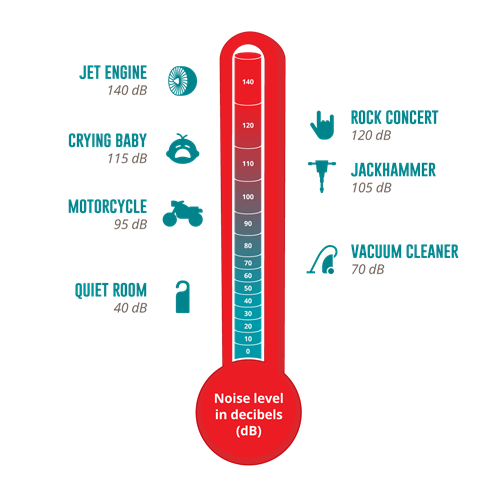Sounds and noises, hustle and bustle. They make life interesting and vibrant. And sound can help us switch off too. But how do we keep our hearing safe? Read this blog for some expert tips.
Are your headphones too loud?
Our headphones let us disappear into a private world of music or a podcast. These days, it’s normal to see people with earbuds in their ears or giant headphones on their heads.
However, it’s important to keep the volume down to a safe level. According to the World Health Organization (WHO), the sound intensity produced in headsets can reach the same level as a rock concert. In fact, 1.1 billion young people worldwide are also at risk of hearing loss due to unsafe listening practices.
Expert tip: Check the colour of your device’s volume indicator to see if the volume is approaching dangerous levels.
Can you feel when you’re in danger of hearing loss?
It would be good if we could feel when our hearing was in danger. Unfortunately, there’s no reliable way to know for sure if you are in danger of hearing loss. However, there are some hearing loss warning signs that you shouldn’t ignore.
3 warning signs that your hearing is in danger
1. Tinnitus. If your ears are ringing or whining after a loud event, it’s a clear indication they have been exposed to high volume sound.
2. ‘Muffled’ hearing, known as temporary hearing loss. This can occur after a loud event such as a music concert, or going to the cinema, or even a fitness class.
3. You need to raise your voice to make yourself understood.
Expert tip: If you notice any of these warning signs, avoid loud noises until your hearing has returned to normal.
What is a safe volume level?
85 decibels are considered the highest safe exposure level for continuous noise.
Above this level, hearing damage can occur.
Take a look at the illustration. At the lower end, we have safe sounds like a normal conversation or a vacuum cleaner.
The output of personal audio devices may range from 75 dB to as high as 136 dB.
Expert tip: Download a sound level app for your smartphone
Safe listening isn’t just about volume, it’s the duration
The maximum safe exposure time at 85 dB is eight hours.
When sound levels get up above 85 dB – the level of a busy road – the amount of time that you are exposed to it starts to matter.
Once the sound level gets up to the 104 dB, as produced in some nightclubs and bars, and by some power tools such as chainsaws, it takes just 15 minutes before you are at risk of hearing damage.
Expert tip: When listening with earphones for long periods of time, be especially careful to ensure the volume level is safe.
4 ways to prevent hearing loss
Here’s some good news! Noise-induced hearing loss is preventable. You simply need to stay aware of your noise exposure and minimize it whenever it approaches dangerous levels.
1. Use well-fitted earphones and noise cancelling headphones
Because a good fit stops sound leaking out, it allows you to hear your chosen audio clearly without having to turn the volume up towards dangerous levels.
2. Wear earplugs (and fit them correctly):
If you know you are going to be in a noisy place or doing a noisy activity, wear earplugs. Earplugs can help to reduce the level of exposure considerably, by up to 45 decibels.
When do you need to protect your hearing?
3. Take listening breaks
Whether you’re at a loud venue or absorbing an audiobook, it’s a good idea to give your ears a rest from time to time. This reduces your continuous exposure and gives your ears a chance to recover.
4. Get regular hearing check-ups
A hearing test lets you see how you are hearing now. This gives you peace of mind and gives you insights into any listening challenges you may not be aware of. Regular hearing tests allow you and your hearing care expert to track how your hearing develops over time and treat it appropriately.
Find your nearest participating clinic here.